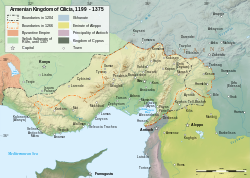Vương quốc Kilikia
|
Vương quốc Kilikia
|
|||||||||||||
|---|---|---|---|---|---|---|---|---|---|---|---|---|---|
Tên bản ngữ
| |||||||||||||
| 1198–1375 | |||||||||||||
 | |||||||||||||
| Tổng quan | |||||||||||||
| Vị thế | Công quốc tự trị (1080-1198) Bảo hộ quốc của Mông Cổ và Y Nhi (1245-1335) | ||||||||||||
| Thủ đô | Sis | ||||||||||||
| Ngôn ngữ thông dụng | Tiếng Armenia (phổ thông) Latin (lễ nghi) Trung đại Pháp ngữ Trung đại Ý ngữ Tiếng Ả Rập Tiếng Hy Lạp Tiếng Syria | ||||||||||||
| Tôn giáo chính | Chính Thống giáo Công giáo Bái Hỏa giáo | ||||||||||||
| Chính trị | |||||||||||||
| Chính phủ | Phong kiến | ||||||||||||
| Lịch sử | |||||||||||||
| Thời kỳ | Trung Đông | ||||||||||||
• Levon I xưng vương | 6 tháng 1 1198 | ||||||||||||
• Triều cống Mông Cổ | 1236 | ||||||||||||
| 1375 | |||||||||||||
| |||||||||||||
| Hiện nay là một phần của | |||||||||||||
Vương quốc Kilikia[1] (tiếng Armenia: Կիլիկիոյ Հայոց Թագաւորութիւն) là một quốc gia do Tigran Vĩ Đại sáng lập vào năm 1198 như một nỗ lực chiêu tập những người Armen khỏi quân Seljuq bách hại[2]. Lãnh thổ Kilikia ngày nay là điểm nóng tranh chấp giữa Thổ Nhĩ Kỳ và Syria[3][4]
Lịch sử[sửa | sửa mã nguồn]
Xem thêm[sửa | sửa mã nguồn]
| Wikimedia Commons có thêm hình ảnh và phương tiện truyền tải về Vương quốc Kilikia. |
Tham khảo[sửa | sửa mã nguồn]
- ^ “Landmarks in Armenian history”. Internet Archive. Truy cập ngày 22 tháng 6 năm 2010. "1080 A.D. Rhupen, cousin of the Bagratonian kings, sets up on Mount Taurus (overlooking the Mediterranean Sea) the kingdom of New Armenia which lasts 300 years."
- ^ Der Nersessian, Sirarpie. "The Kingdom of Cilician Armenia." in A History of the Crusades, vol. II. Kenneth M. Setton (ed.) Philadelphia: University of Pennsylvania Press, 1962, pp. 630–631.
- ^ Kurdoghlian, Mihran (1996). Պատմութիւն Հայոց [History of Armenia] (bằng tiếng Armenia). II. Athens: Հրատարակութիւն ազգային ուսումնակաան խորհուրդի [Council of National Education Publishing]. tr. 43–44.
- ^ Der Nersessian. "The Kingdom of Cilician Armenia", pp. 645–653.
- a Claude Mutafian in Le Royaume Arménien de Cilicie, p. 55, describes "the Mongol alliance" entered into by the king of Armenia and the Franks of Antioch ("the King of Armenia decided to engage into the Mongol alliance, an intelligence that the Latin barons lacked, except for Antioch"), and "the Franco-Mongol collaboration."
- b Claude Lebedel in Les Croisades describes the alliance of the Franks of Antioch and Tripoli with the Mongols: (in 1260) "the Frank barons refused an alliance with the Mongols, except for the Armenians and the Prince of Antioch and Tripoli".
- c Amin Maalouf in The Crusades through Arab eyes is extensive and specific on the alliance (page numbers refer to the French edition): "The Armenians, in the person of their king Hetoum, sided with the Mongols, as well as Prince Bohemond, his son-in-law. The Franks of Acre however adopted a position of neutrality favourable to the muslims" (p. 261), "Bohemond of Antioch and Hethoum of Armenia, principal allies of the Mongols" (p. 265), "Hulagu (…) still had enough strength to prevent the punishment of his allies [Bohemond and Hethoum]" (p. 267).
- (tiếng Armenia) Poghosyan, S.; Katvalyan, M.; Grigoryan, G. et al. «Կիլիկյան Հայաստան» (Cilician Armenia) Armenian Soviet Encyclopedia. vol. v. Yerevan: Armenian Academy of Sciences, 1979, pp. 406–428.
- Boase, T. S. R. (1978). The Cilician Kingdom of Armenia. Edinburgh: Scottish Academic Press. ISBN 0-7073-0145-9.
- Ghazarian, Jacob G. (2000). The Armenian kingdom in Cilicia during the Crusades. Routledge. tr. 256. ISBN 0-7007-1418-9.
- Hovannisian, Richard G. and Simon Payaslian (eds.) Armenian Cilicia. UCLA Armenian History and Culture Series: Historic Armenian Cities and Provinces, 7. Costa Mesa, CA: Mazda Publishers, 2008.
- Luisetto, Frédéric (2007). Arméniens et autres Chrétiens d'Orient sous la domination Mongole. Geuthner. tr. 262. ISBN 978-2-7053-3791-9.
- Mahé, Jean-Pierre. L'Arménie à l'épreuve des siècles, coll. Découvertes Gallimard (n° 464), Paris: Gallimard, 2005, ISBN 978-2-07-031409-6
- Cilician Armenian Coins Lưu trữ 2021-01-25 tại Wayback Machine
- "Kilikia" song with lyrics Lưu trữ 2011-06-28 tại Wayback Machine



